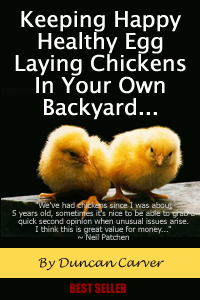“I have had my 16 hens for a year now, and have not had a problem until this summer. They are pecking each others’ feathers out. My hens are a variety of Rhode Island Reds, Orpingtons, Australorps, Wyandottes, and Leghorns (I wanted color!). I feed a complete crumble, plenty of water and roosting space, they are let out of their pen every evening for a couple hours before sunset.
I was told I needed a rooster to calm the hens down, so a got a real nice brahma rooster, but that didn’t make any difference. They lay nice eggs averaging about 12 to 14 a day. They started out pecking the feathers around their rear ends, then the backs, and some even on the heads, they look terrible. Any ideas what could help? Thanks for any advice!” ~ Pat
Hi Pat,
I’m sorry you’re having problems with feather pecking this summer but I’m glad you wrote because I have a couple of ideas for you.
There are a few possibilities behind this behavior.
Limited space can cause stress and therefore, aggressive behavior.
You didn’t mention how much space is available to your flock while they are confined so I’ll share some parameters for that and you can determine if it might be part of the problem.
A fully confined flock requires 5-8 square feet per bird within the coop.
A flock that is free ranged all day requires at least 4 square feet per bird of coop space.
Because your flock experiences a combination of free range and confinement, they would appreciate at least 5-6 square feet per bird within the coop.
Since your flock is confined for most of its waking hours, I’d suggest using a guideline of 8-12 square feet per bird within the run.
If your set up is within the above guidelines, boredom might be part of the problem.
I don’t know if you have children but I do know that if I want to guarantee bickering amongst my children, all I have to do is help them achieve boredom.
Chickens are much the same way; if they don’t have enough to keep them entertained, they start to fight. (Especially Rhode Island Reds – in my experience.)
It can be difficult to keep our flocks busy when they are confined so we have to get creative.
One of my favorite suggestions is to hang a wire basket full of greens just out of reach of the chickens. You can see just what a determined bunch you have when they jump and jump to get to the yummy treat.
Another fun thing to do, if you have the space is to create different levels within the run with bales of straw. The flock will also enjoy it if you create tunnels out of the straw for them to explore, or give them a place to escape the feather pecking. Really anything that changes the topography of their space will be of benefit.
In the past, I’ve suggested hanging old CDs from the top of the coop because the chickens like to watch the sun reflect off of them and seem mesmerized as they spin in the breeze. I hesitated to add that suggestion because someone’s chicken got a hold of one last year and died after apparently eating it.
Let me make this perfectly clear – do not allow your chickens access to anything that they can’t eat!
Chickens will eat just about anything and I can’t stress strongly enough your need to restrict their access to things that are dangerous for them to ingest.
As in the case of the CDs, you must hang them out of reach of the chickens and check regularly to make sure they are securely fastened.
Get creative.
Think like a chicken and ask yourself what might be of interest to you. How would you want to pass your time? Don’t be afraid to get down and look at the world from their perspective. Use what you already have to safely create a more interesting area for your confined flock.
I would also have suggested getting a rooster. I’m sorry this hasn’t helped Pat.
For others reading, a rooster will often calm a flock of ladies for a number of reasons.
For instance, a rooster “alarms” to let the hens know when danger is present so they can get to safety. He will often then rush out into the face of danger in an attempt to protect his girls, sometimes sacrificing himself.
And or course, a rooster can keep a bunch of bickering ladies “busy” so they aren’t so focused on each other.
Depending upon the age of the hens and that of the rooster, he will likely take his place as leader, creating a sense of order within the flock.
Sometimes there is one culprit that is the head feather pecker. This might not be something you’d want to consider but culling that hen might break the others of the behavior. It’s not that they’re smart enough to consider a similar fate, quite the opposite.
If the initiator is gone, the others might forget all about the behavior, especially if they have other thing to keep them busy.
Finally, feather pecking can be a sign of a calcium deficiency.
You didn’t mention a calcium supplement, I recommend free choice oyster shell be made available for all flocks, feather pecking or not.
Egg shells are made up mostly of calcium carbonate so additional calcium is beneficial for the formation of strong shells.
Pat, I hope some of these suggestions will be of help. Thanks again for the question.


